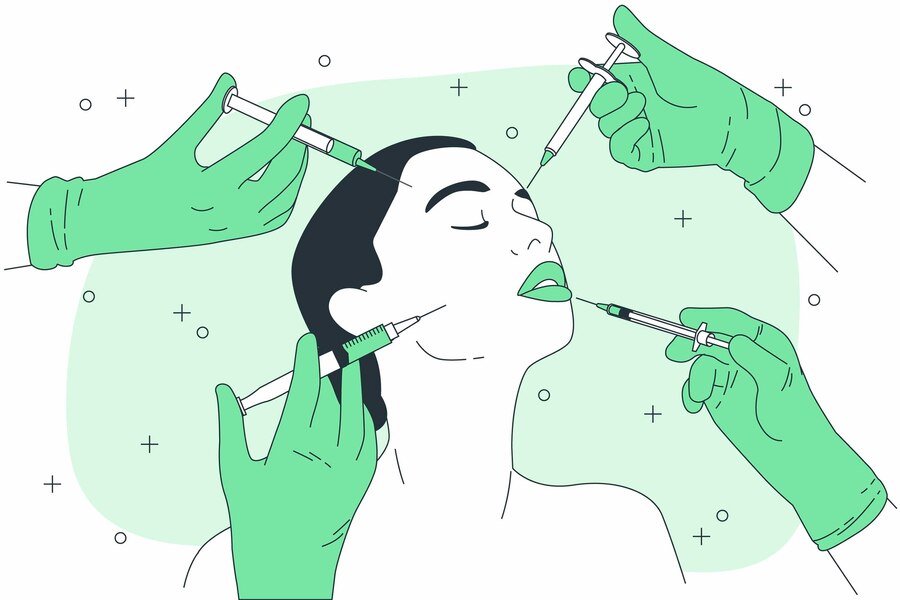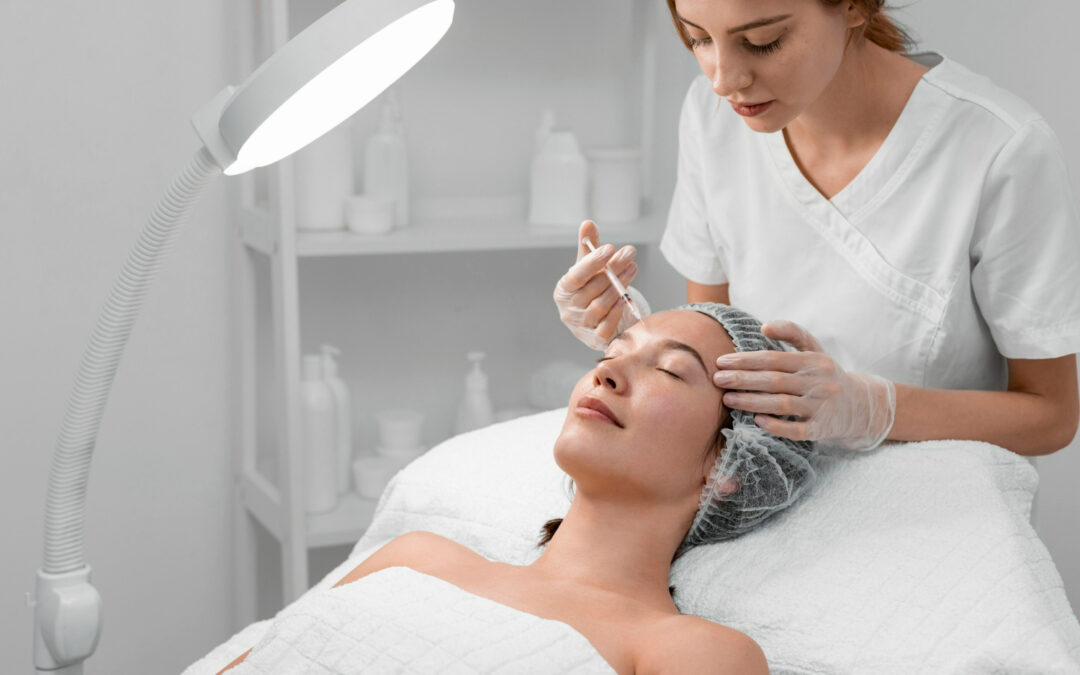There lies a need for a deeper understanding of what an anti-wrinkle injection entails before going ahead and getting yourself such treatment.
This blog is your comprehensive guide, dissecting the intricacies of anti-wrinkle injections and shedding light on the science that underpins this transformative skincare solution.
What is an anti-wrinkle injection?
An anti-wrinkle injection is often based on neurotoxins like Botulinum Toxin. It temporarily relaxes the muscles.
The benefits of anti wrinkle injections are mainly to combat the visible signs of aging—erasing frown lines, crows feet, fine lines and wrinkles. Beyond treating existing wrinkles, these injections can act preventatively, slowing down the formation of new lines.
Contrary to what most people think, the discomfort one will feel in this procedure is kept to a minimum. It’s like a quick pinch. The use of fine needles makes it more comfortable. Additionally, practitioners often use numbing agents or simply ice packs to alleviate any potential discomfort further.
How does an anti-wrinkle injection work?
A trained medical professional strategically injects small amounts of the neurotoxin into targeted facial muscles. The neurotoxin acts as a disruptor, inhibiting the release of acetylcholine, a neurotransmitter responsible for muscle contractions. Temporarily blocking these nerve signals will have the injected muscles undergo a controlled and subtle paralysis.
Different types of neurotoxins are used in anti-wrinkle injections, each offering unique formulations and characteristics:
|
Neurotoxin |
Active Ingredient |
Onset Time |
Duration |
Complexing Proteins |
Innovation |
|
Botox |
Quick |
Varied |
Yes |
Establish efficacy |
|
|
Dysport |
Quick |
Varied |
Yes |
Muscle-relaxing properties |
|
|
Xeomin |
Delayed |
Varied |
No (Pure Formulation) |
Reduced risk of antibody resistance |
|
|
Jeuveau |
Varied |
Varied |
Yes |
Modern formulation for swift results |
|
|
Daxxify |
Varied |
Extended |
Yes |
Peptide delivery system for innovation |
Based on the assessment, your preferences, and perhaps your medical history, the practitioner may suggest a specific type or brand that aligns with your goals. They will take into account factors such as the type of wrinkles you want to address, the desired level of correction, and your lifestyle.
If you have preferences for a particular brand or type, discuss them with the practitioner. A collaborative approach ensures that you feel confident and informed about the chosen course of action.
It is worth mentioning the concept of the “lip flip.” Certain anti-wrinkle injections, when strategically administered around the upper lip, can create a subtle lifting effect, enhancing the appearance of the lips without the need for dermal fillers.
In some cases, anti-wrinkle injections can lead to temporary muscle weakness, particularly if the injection is not administered with precision.
Onset time and duration
It will take some time before you see the results. While some individuals may observe results within a few days, the full effect typically takes a week or two to manifest. The longevity of these injections varies, ranging from three to six months, after which muscle activity gradually returns.
While the suggested time between treatments varies, most practitioners suggest a touch-up three to four months apart. It matters based on the specific anti-wrinkle injection used, the targeted treatment area, and individual response to the treatment. During a consultation, a qualified practitioner will assess your unique skin characteristics and formulate a tailored plan that aligns with your aesthetic goals.
Situations or conditions where one cannot get an anti-wrinkle injection
Anti-wrinkle injections may not be advisable for those who:
- Are pregnant and breastfeeding.
- Have neuromuscular disorders such as myasthenia gravis or Lambert-Eaton syndrome.
- Have known allergies to any ingredients in the injection, especially botulinum toxin type A.
- Have an existing skin infection or inflammation at the injection site.
- Are taking certain medications like blood thinners or muscle relaxants.
- Have autoimmune diseases, such as rheumatoid arthritis or lupus.
Before considering anti-wrinkle injections, a thorough consultation with a qualified healthcare professional is essential.
Post-treatment guidelines:
What not to consume
Maintaining a specific dietary approach can contribute to a successful recovery after an anti-wrinkle injection. Here’s a professional guide on foods and drinks to avoid:
- Blood-thinning foods like garlic, ginger, turmeric, and omega-3-rich foods can potentially increase the risk of bruising (so can alcohol).
- Caffeine and energy drinks (stimulants) can heighten sensitivity and contribute to post-treatment discomfort.
- Salty and spicy foods can contribute to temporary swelling at the injection site.
What not to do
After undergoing an anti-wrinkle injection, there is a set of post-treatment guidelines you must adhere to optimize results and ensure a smooth recovery. Here’s a definitive list of what to avoid:
- Vigorous exercise: Intense physical activity may increase blood flow, potentially affecting the distribution of the injected substance. Steer clear of strenuous workouts for at least 24 hours post-treatment.
- Facial Manipulation: Excessive touching, rubbing, or massaging of the treated area can displace the injected solution. Resist the temptation to touch or manipulate the treated areas to allow the injection to settle.
- Excessive Sun Exposure: UV rays can exacerbate inflammation and compromise the effectiveness of the injection. Wear sunblock and limit sun exposure immediately after the procedure.
- Alcohol Consumption: Alcohol can thin the blood and potentially increase the risk of bruising at the injection site. Abstain from alcohol for at least 24 hours post-treatment.
- Sauna and hot baths: Heat can dilate blood vessels, increasing the potential for bruising. Avoid saunas, hot baths, or prolonged exposure to hot environments.
Should I apply anti-wrinkle cream after an anti-wrinkle treatment?
Yes, but with a strategic approach. Avoid immediate application on the treated areas. Give the injected areas a bit of breathing room to let the magic of the injection work its way into your skin. After a day or two, resume your anti-wrinkle cream routine, ensuring gentle application.
Can I wear makeup after an anti-wrinkle treatment?
Yes, but a touch of caution is warranted. Post-injection, wait at least 24 hours before reaching for your makeup bag. This grace period allows the treated areas to settle and reduces the risk of irritation. Opt for mineral-based makeup, which is generally gentler on the skin and less likely to interfere with the effects of the injection.

Where can you get an anti-wrinkle injection?
Anti-wrinkle injections have proven to be a formidable ally in the pursuit of timeless beauty. For those ready to embark on this transformative journey, consider entrusting your beauty aspirations to a reputable establishment.
Christopher Hanna stands out as a luxury salon, where expertise meets elegance. Renowned for its excellence in nail and hair treatments, Christopher Hanna also proudly provides anti-wrinkle injection treatments.
Embark on your beauty evolution with confidence, guided by the expertise of Christopher Hanna—a sanctuary where sophistication and innovation converge to redefine your aesthetic journey.
